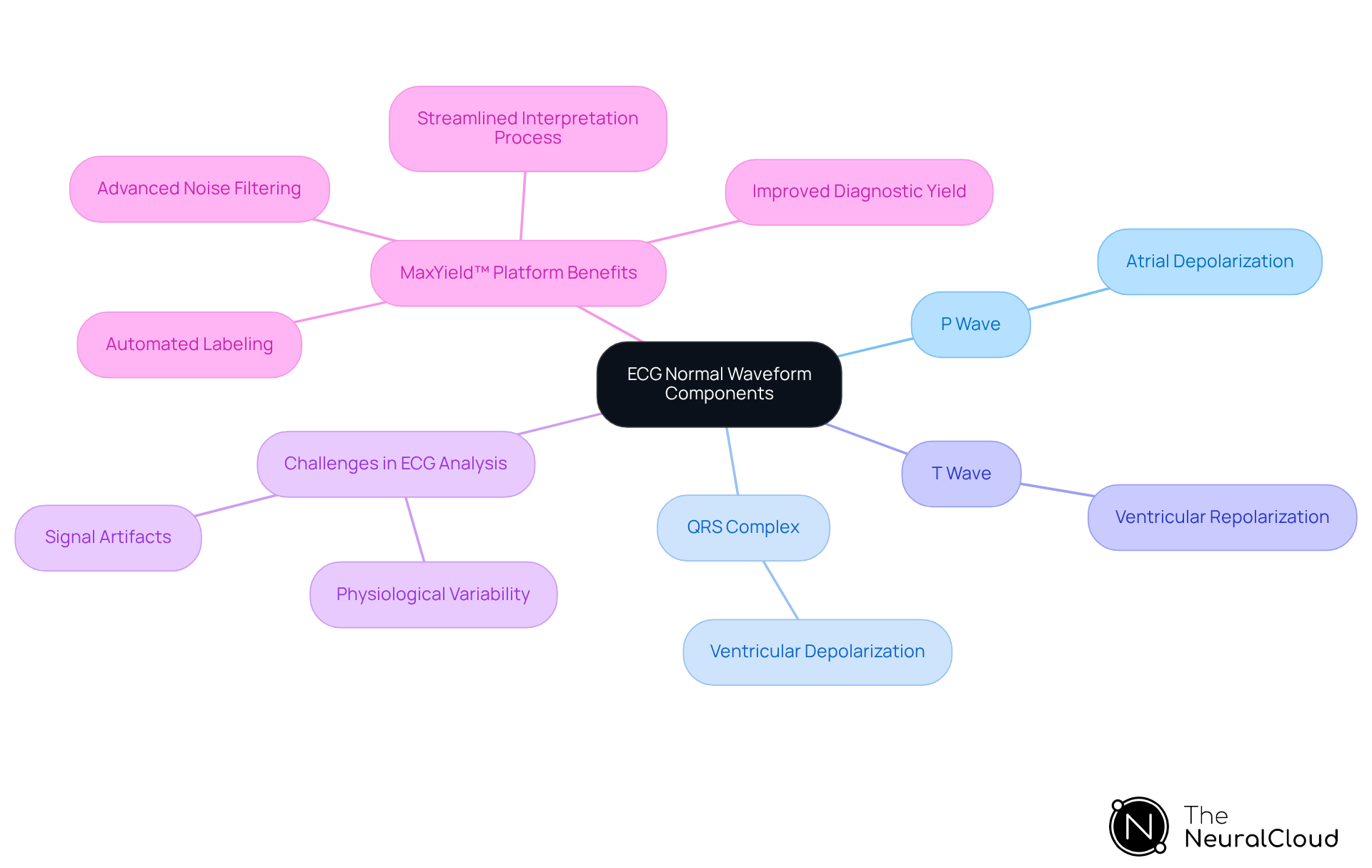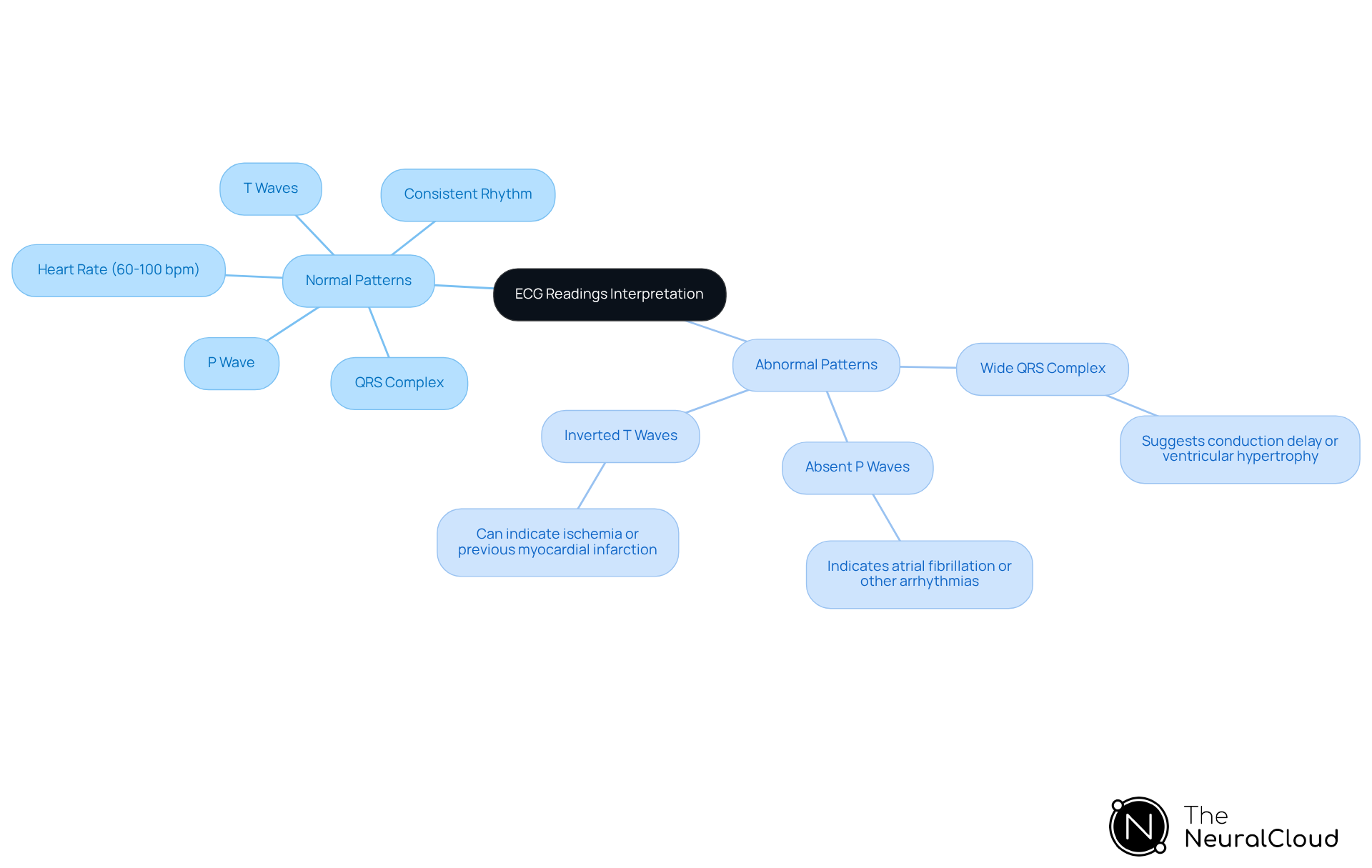Overview
The article addresses the essential elements of the ECG normal waveform, particularly the P wave, QRS complex, and T wave, along with their importance in interpreting cardiac health. It discusses the challenges faced in ECG analysis, underscoring how a comprehensive understanding of these components can enhance diagnostic accuracy. The integration of advanced technology, such as Neural Cloud Solutions' MaxYield™, is highlighted for its role in improving the efficiency of ECG analysis. This platform enhances noise filtering and automates labeling, which significantly aids healthcare professionals in diagnosing various cardiac conditions. By leveraging these advanced features, MaxYield™ not only streamlines the analysis process but also increases the reliability of the results, ultimately benefiting patient care.
Introduction
Understanding the intricacies of the ECG normal waveform is crucial for healthcare professionals tasked with diagnosing cardiac conditions. This tutorial delves into the essential components of the ECG—namely the P wave, QRS complex, and T wave—highlighting their significance in heart health assessment. However, healthcare professionals often face challenges in accurately interpreting these waveforms due to physiological variability and noise. This raises an important question: how can advanced technologies, such as the MaxYield™ platform, transform ECG analysis into a more efficient and reliable process?
The MaxYield™ platform offers a range of features designed to enhance ECG analysis. It utilizes advanced algorithms to filter out noise and improve waveform clarity, enabling healthcare professionals to make more accurate diagnoses. Furthermore, the platform provides real-time data analysis, allowing for quicker decision-making in clinical settings. These features not only streamline the ECG interpretation process but also enhance the overall quality of patient care.
By adopting the MaxYield™ platform, healthcare professionals can experience significant benefits. The improved accuracy in ECG interpretation leads to better patient outcomes and reduces the likelihood of misdiagnosis. Additionally, the platform's user-friendly interface ensures that even those with limited technical expertise can navigate it effectively. This accessibility empowers all healthcare providers to leverage advanced technology in their practice.
In conclusion, the MaxYield™ platform stands as a transformative tool in the realm of ECG analysis. By addressing the challenges faced by healthcare professionals, it enhances the accuracy and efficiency of cardiac assessments, ultimately benefiting patient care.
Define the ECG Normal Waveform Components
The ECG normal waveform consists of several key components: the P wave, QRS complex, and T wave, each representing specific electrical activities of the heart.
- P Wave: Reflects atrial depolarization, indicating the electrical activity that triggers atrial contraction.
- QRS Complex: A combination of three waves (Q, R, and S) representing ventricular depolarization, the electrical impulse that causes ventricular contraction.
- T Wave: Signifies ventricular repolarization, the process by which the ventricles recover after contraction.
Understanding these components is essential for accurate ECG interpretation and diagnosing potential cardiac issues, especially in relation to the ECG normal waveform. However, ECG analysis often faces challenges such as physiological variability and signal artifacts, which can complicate the interpretation process. The integration of Neural Cloud Solutions' MaxYield™ platform enhances ECG analysis efficiency through automated labeling and advanced noise filtering.
The MaxYield™ platform effectively addresses these challenges by ensuring critical data is identified and labeled, even in recordings with high noise levels. This innovative approach not only but also streamlines the ECG interpretation process. As a result, healthcare professionals can make accurate heart health assessments more efficiently, benefiting from enhanced clarity and precision in their analyses.

Analyze the Characteristics of P-Wave, QRS Complex, and T-Wave
Each component of the ECG normal waveform displays distinct characteristics that can indicate various cardiac conditions. The integration of Neural Cloud Solutions' MaxYield™ significantly enhances the efficiency of analyzing these components:
-
P Wave:
- Duration: Typically lasts 80 milliseconds.
- Amplitude: Should be upright in leads I and II, and inverted in aVR.
- Significance: Abnormalities in the P wave can indicate atrial enlargement or other atrial pathologies. The MaxYield™ system improves the identification of these abnormalities by ensuring that the ECG normal waveform is clearer through automated labeling and noise reduction capabilities, even in challenging recordings.
-
- Duration: Normal duration is less than 120 milliseconds.
- Morphology: The QRS complex should be narrow; a wide complex may suggest a conduction delay or ventricular hypertrophy.
- Significance: Changes in the QRS complex can indicate myocardial infarction or other ventricular issues. With MaxYield™, the analysis of the QRS complex, which reflects the ECG normal waveform, is streamlined, allowing for rapid identification of critical changes in morphology amidst noise and artifacts.
-
T Wave:
- Duration: Generally follows the QRS complex and should be upright in most leads.
- Amplitude: The height of the T signal can vary; however, significant deviations may indicate ischemia or electrolyte imbalances.
- Significance: T abnormalities are often linked to various cardiac conditions, including ischemia and repolarization disorders. The system provides detailed insights into T wave characteristics, facilitating confident clinical decision-making by filtering out noise and enhancing the clarity of the ECG normal waveform.
The MaxYield™ system processes 200,000 heartbeats in under 5 minutes, transforming noisy recordings into detailed insights. This capability assists health tech developers in effectively into their platforms.

Interpret ECG Readings: Normal vs. Abnormal Patterns
Interpreting ECG readings involves recognizing the differences between normal and abnormal patterns. The integration of advanced technologies, such as Neural Cloud Solutions' MaxYield™, significantly enhances the efficiency of this process.
A consistent rhythm is displayed in the ECG normal waveform, with a heart rate ranging from 60 to 100 beats per minute. Each P wave precedes a QRS complex, and T waves are typically upright in most leads. The MaxYield™ system improves the identification of these patterns by filtering out noise and artifacts, ensuring that critical data is accurately labeled, even in challenging recordings. Furthermore, the algorithm evolves with each use, continuously enhancing its accuracy and efficiency in recognizing the ECG normal waveform patterns.
Abnormal Patterns:
- Absent P Waves: This may indicate atrial fibrillation or other arrhythmias.
- Wide QRS Complex: Suggests a conduction delay or ventricular hypertrophy, warranting further investigation.
- Inverted T Waves: Can indicate ischemia or a previous myocardial infarction.
Recognizing these patterns is essential for diagnosing conditions such as arrhythmias, myocardial infarction, and other cardiac abnormalities. With MaxYield™, clinicians can address inefficiencies caused by and signal artifacts, leading to more reliable interpretations. It is crucial for clinicians to correlate ECG findings with clinical symptoms and other diagnostic tests to ensure comprehensive patient assessment.

Conclusion
Understanding the components of the ECG normal waveform is crucial for accurate cardiac assessment. The P wave, QRS complex, and T wave each play a vital role in reflecting the heart's electrical activities, allowing healthcare professionals to diagnose various cardiac conditions effectively. By mastering these components, one can enhance the interpretation of ECG readings and improve patient outcomes.
The article highlighted the significance of each waveform component, detailing their characteristics and clinical relevance. It emphasized how the MaxYield™ platform from Neural Cloud Solutions optimizes ECG analysis by automating labeling and reducing noise. This ultimately enables clearer interpretations. By streamlining the identification of normal and abnormal patterns, this technology aids clinicians in making informed decisions swiftly and accurately.
In conclusion, the integration of advanced tools like MaxYield™ simplifies the ECG interpretation process and enhances diagnostic accuracy. As the medical field continues to evolve, embracing innovative solutions will be essential for improving heart health assessments. Healthcare professionals are encouraged to leverage these technologies to ensure comprehensive evaluations and better patient care, ultimately leading to more effective management of cardiac health.
Frequently Asked Questions
What are the main components of the ECG normal waveform?
The main components of the ECG normal waveform are the P wave, QRS complex, and T wave.
What does the P wave represent in an ECG?
The P wave reflects atrial depolarization, indicating the electrical activity that triggers atrial contraction.
What does the QRS complex signify in an ECG?
The QRS complex is a combination of three waves (Q, R, and S) that represent ventricular depolarization, which is the electrical impulse that causes ventricular contraction.
What does the T wave indicate in an ECG?
The T wave signifies ventricular repolarization, the process by which the ventricles recover after contraction.
Why is it important to understand the components of the ECG normal waveform?
Understanding these components is essential for accurate ECG interpretation and diagnosing potential cardiac issues.
What challenges are associated with ECG analysis?
ECG analysis often faces challenges such as physiological variability and signal artifacts, which can complicate the interpretation process.
How does Neural Cloud Solutions' MaxYield™ platform enhance ECG analysis?
The MaxYield™ platform enhances ECG analysis efficiency through automated labeling and advanced noise filtering, ensuring critical data is identified and labeled even in recordings with high noise levels.
What benefits does the MaxYield™ platform provide for healthcare professionals?
The MaxYield™ platform improves diagnostic yield and streamlines the ECG interpretation process, allowing healthcare professionals to make accurate heart health assessments more efficiently with enhanced clarity and precision.






